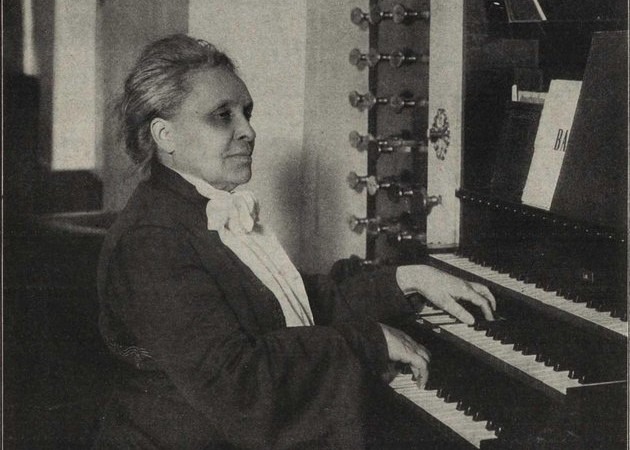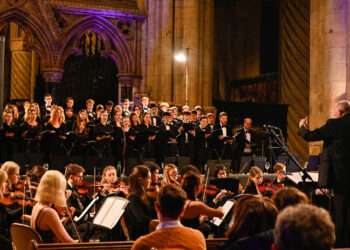Durham University Choral Society’s summer concert was built around an imaginative pairing of Gabriel Fauré’s very well-known and much loved Requiem with a Lutheran mass by Fauré’s close contemporary Elfrida Andrée – a piece that was probably getting its first UK performance.
These two pieces were also very well matched in mood and harmonic language, so much so that at times during the Andrée mass setting, I thought out of the corner of my ear that we were about to swerve into the Fauré already. Both pieces were written for choir and organ, and the harp that is additionally required for the Andrée mass was then brought back to accompany the Fauré Sanctus.
Andrée’s Svensk Mässa No.1 opened with solid, rounded singing and nicely shaped long phrases. Much of the full choral writing in this piece was dignified, self-assured and nicely constructed – music for solid burghers in pretty North European towns, the quintessence of Lutheran Protestantism (in a good way). There were also some lyrical passages for solo soprano which contrasted nicely, and some more complex unaccompanied choral writing, although the choir seemed a bit shaky during these sections.
As well as being a composer, Andrée was the first woman to be appointed to a cathedral organist job in Scandinavia, after lobbying the King of Sweden to give her the job, and her knowledge of the instrument shows in this mass setting. There was always something interesting going on in the organ part, and conductor John Forsyth and organist Andrew Reid balanced choir and organ extremely effectively so that we could appreciate both. There was also a dramatic solo organ movement which could easily work as a stand alone piece, and my organist concert companion said that the piece made good use of the lovely strings on Durham Cathedral’s Harrison and Harrison organ.
However, although this was a really interesting and attractive piece that was sung with style and conviction, we would all have benefitted from a little more information in the programme so that we could get our bearings in an unfamiliar piece, sung in a foreign language. Even without really knowing any Swedish, it became clear from the mood and lengths of the movements that this did not follow the familiar Latin mass structure, so a list of movement titles and translations would have made a world of difference. For anyone interested, there’s a list of movements here, and a quick google-translate job tells me that the work is made up of some mass movements (Kyrie, Gloria, Sanctus and Agnus Dei) alongside Lutheran hymns and other prayers.
Grieg’s Fire Salmen (Four Psalms), a rare example of Grieg writing religious music, and the last thing he wrote. Despite the title, the texts are actually what we would call hymns rather than Biblical Psalms, and Grieg’s unaccomapanied settings are based on folk tunes, embroidered with lavish harmony. (Texts and translations can be found here).
Although the inclusion of the Grieg made the first half rather long, it was good to be introduced to them and they produced some excellent singing from DUCS – the hesitancy in the unaccompanied passages of the Andrée was nowhere to be seen here. The first movement, Hvad est du dog skjøn, (How beautiful thou art), flowed with a hypnotic, chant-like lilt which was very effective. In Guds Søn har gjort mig fri, (God’s son hath set me free) a cheery dance framed a contrasting section for tenors and basses, with a solo baritone, and very effective delivery of the dense, tightly packed harmonies. The final psalm, I Himmelen, I Himmelen (In heaven’s hall, in heaven’s hall) glowed with warmth and I didn’t need to know the text or title of this one to know that it was full of joy,
After these Scandinavian treats, both of which I’d happily go to hear again, we returned to familiar territory of Fauré’s Requiem. Singing such a popular work has its own challenges of course – the performers need to convice the listener that they bring something of their own – and there was much to enjoy in this performance, right from the poise of the start, with a good legato line joining up the punctuated choir and organ chords. This legato and sense of line also benefited the Kyrie and Agnus Dei, when it’s all too easy to get bogged down by the sheer gorgeousness of Fauré’s melodies. And as an alto, I can’t not mention the lovely rich singing in the Offertorium, set against the spookiness of the organ.
Again, the choir were strong enough that Andrew Reid was able to give the organ plenty of welly (technical term) without overwhelming them, so the dramatic Requiem and Libera Me sections really thrummed – the Dies Irae part of the Libera Me was delivered with urgency and desperation and had a powerful emotional impact. By contrast, the Hosanna at the end of the Sanctus was filled with rapture, immediately dying into a carefully controlled pianissimo and there was some really beautiful sustained quiet singing from the sopranos in the final In Paradisum.
Image: Elfrida Andrée at the organ console in Gothenburg Cathedral.








